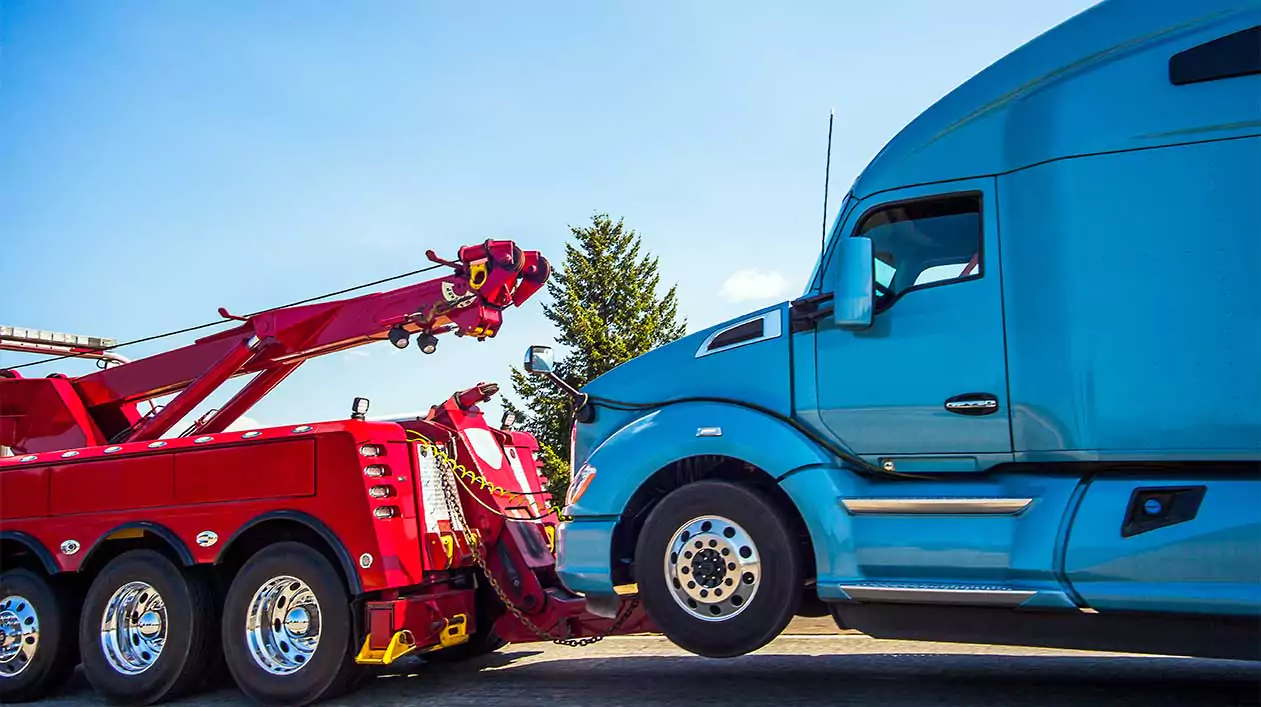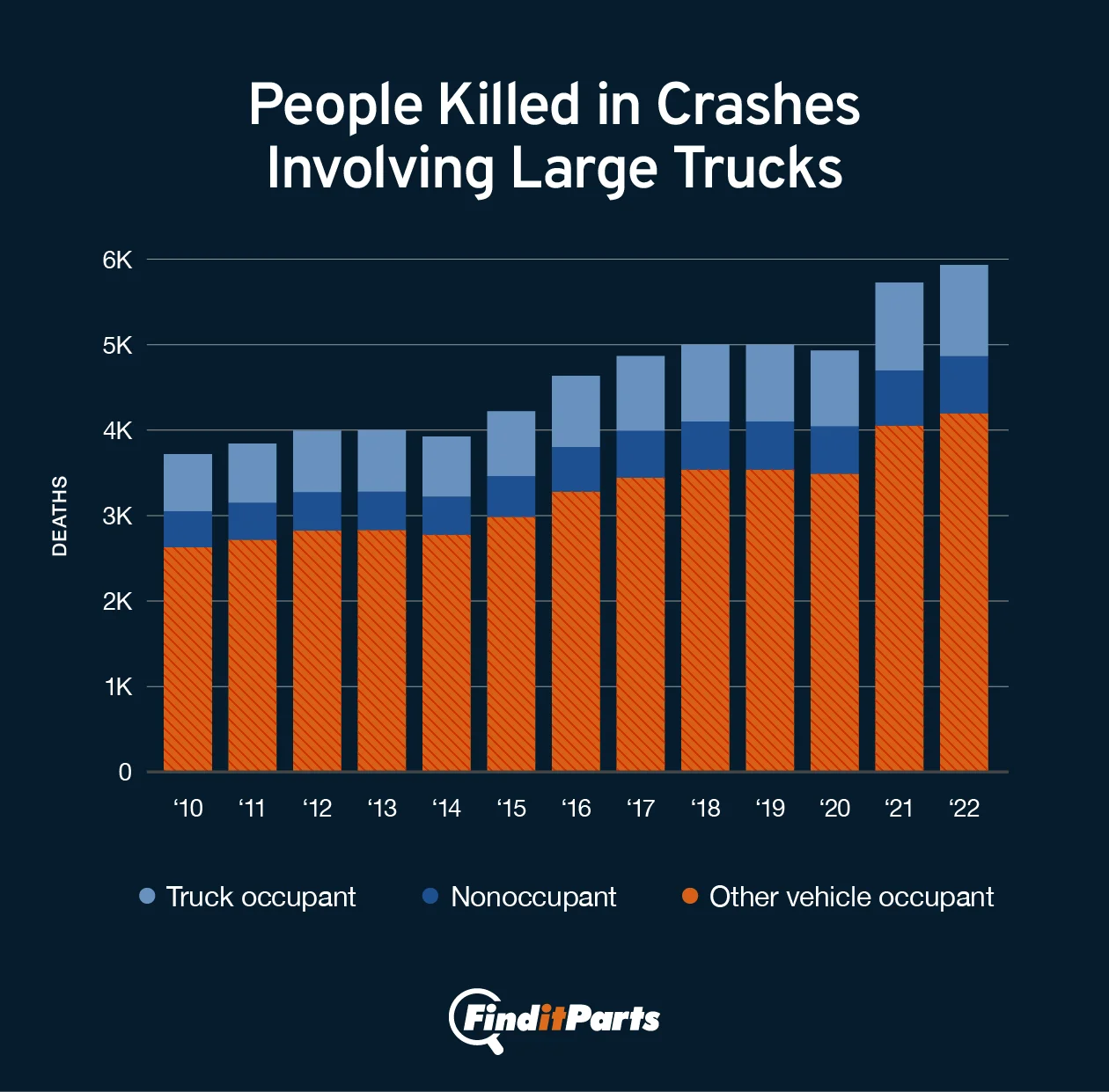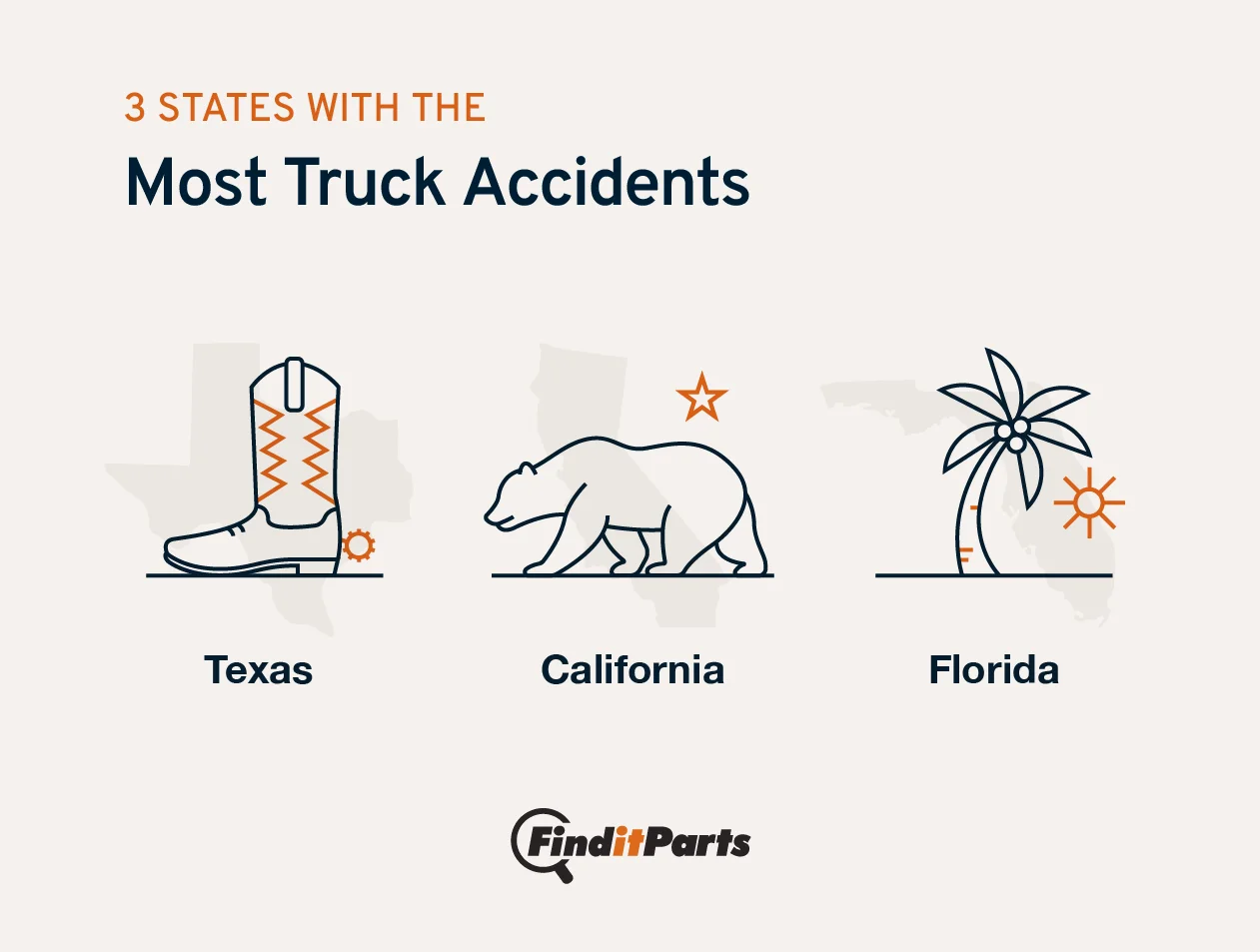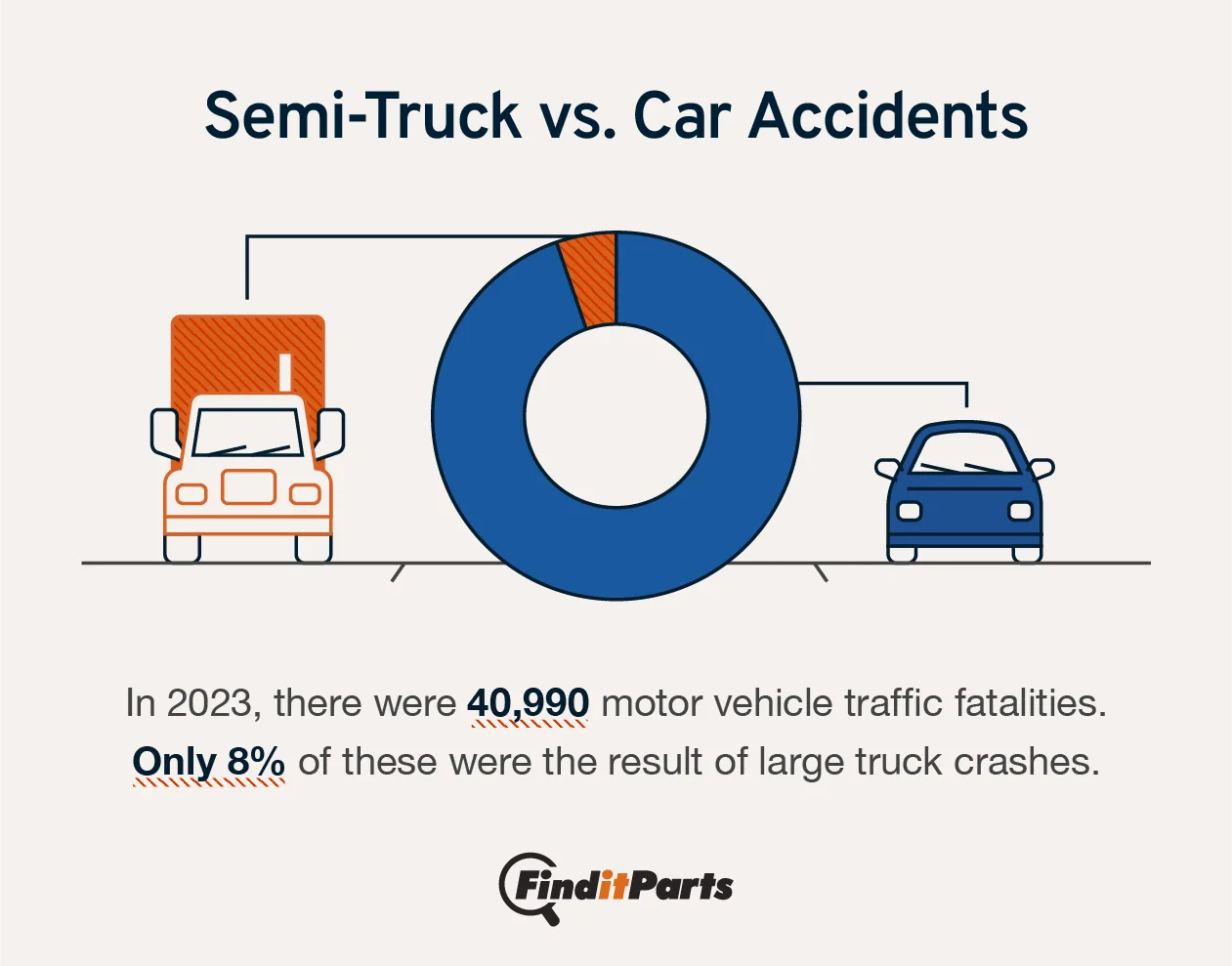Need help? We're here!
(888) 312-8812 Login SignupTruck Accident Statistics: Semi Crash Trends to Know for 2025
August 12, 2024

In the last two decades, there have been great strides in vehicle safety technology: lane keep assist, blind spot monitoring, enhanced cameras and sensors, and collision mitigation systems. But while these features have made their way into passenger vehicles and large trucks alike, they haven't reduced the number of truck crashes that occur each year. In fact, that number has risen steadily since 2010.
To increase awareness of road safety issues, we've brought together 40 truck accident statistics that cover everything from general year-over-year trends to crash rates by state, road length, and collision type.
Key Findings:
- Only 5% of Americans can correctly identify all of a semi-truck's blind spots. (FinditParts)
- From 2010 to 2021, the number of fatal crashes involving large trucks or buses increased by 52%. (Federal Motor Carrier Safety Administration)
- 62% of drivers say they've witnessed other drivers unsafely tailgating trucks, and 64% report seeing another driver change lanes dangerously in front of a semi. (FinditParts)
- In 2023, there were 40,990 motor vehicle traffic fatalities. Only 8% of these were the result of large truck crashes. (National Highway Traffic Safety Administration)
- Around one-third of Americans don't know how to safely pass semis. (FinditParts)
Table of Contents:
- Truck Accident Trends
- Truck Crash Rate by Road Length
- Truck Accidents by State
- Semi-Truck vs. Car Accident Statistics
- Costs Associated With Truck Accidents
- General Truck Accident Statistics
- Semi-Truck Road Safety Statistics
- Tips for Avoiding Truck Accidents
- Methodology
Commercial Truck Accident Trends
Despite improved safety technology and regulations like the electronic logging device (ELD) mandate in 2017, the average number of yearly truck crashes has risen steadily over the last decade and a half.
1. From 2010 to 2021, the number of fatal crashes involving large trucks or buses increased by 52%. (Federal Motor Carrier Safety Administration)
2. Between 2020 and 2021, there was a 20% increase in the number of fatalities resulting from truck crashes. (National Safety Council)
3. As of June 2024, there have been 76,682 commercial truck and bus crashes in the U.S. this year. (Federal Motor Carrier Safety Administration)
4. Large truck occupant fatalities increased by 8.5% from 2021 to 2022. (National Highway Traffic Safety Administration)
5. The total number of fatal and non-fatal crashes involving commercial trucks decreased 7% between 2021 and 2023. (Federal Motor Carrier Safety Administration)
6. Truck accidents are more likely to occur from September to December. In 2022, the number of fatal crashes for these months was 5% higher than for May through August and 14% higher than for January through April. (National Safety Council)
Key takeaway: Year over year, the number of people killed in large truck crashes has increased substantially from 2010 to 2022.
Truck Crash Rate by Road Length
While crunching data for our dangerous truck roads study, we determined the rate of truck crashes per 100 miles for all 50 states—and the results were surprising.
7. Based on crash data from 2023, Maryland has a large truck crash rate of 5.7 accidents per 100 miles of road—the highest in the nation. (Federal Motor Carrier Safety Administration; Federal Highway Administration)
8. Despite their relatively low populations, Delaware and Connecticut have the second and fourth highest semi-truck crash rates in the country: 4.4 and 3.8 accidents per 100 miles, respectively. (Federal Motor Carrier Safety Administration; Federal Highway Administration)
9. Texas has the most road miles of any U.S. state (654,923 miles) and a crash rate of 3.1 per every 100 miles—the eighth highest in the country. (Federal Motor Carrier Safety Administration; Federal Highway Administration)
10. Alaska, South Dakota, and North Dakota have the lowest truck crash rates in the U.S., with 0.16, 0.32, and 0.35 accidents per 100 miles, respectively. (Federal Motor Carrier Safety Administration; Federal Highway Administration)
Key takeaway: Small states like Maryland, Delaware, and Connecticut have higher semi-truck crash rates per 100 miles than large, populous, high-mileage states like Texas and California.
Commercial Truck Accidents by State
Texas
$1,967
Large Truck Crashes per 100 Miles of Roadway
0
1
2
3
4
5
6
Trucking routes can take you anywhere in the country, and driving through certain states may increase your likelihood of being involved in an accident.
11. In 2023, there were 20,537 large truck crashes in Texas, the most of any U.S. state. (Federal Motor Carrier Safety Administration)
12. California and Florida had the second and third highest number of truck accidents in 2023, with 13,105 and 10,378 incidents, respectively. (Federal Motor Carrier Safety Administration)
13. As of June 2024, Texas has the highest number of large truck crashes of any state this year (8,786 fatal and non-fatal crashes). (Federal Motor Carrier Safety Administration)
14. Yearly truck accidents in Texas have increased by 13% since 2020. (Federal Motor Carrier Safety Administration)
15. Alaska had the lowest number of truck accidents of any state in 2023 (50 reported crashes). Within the contiguous United States, Vermont had the lowest number of accidents (172 reported crashes). (Federal Motor Carrier Safety Administration)
Key takeaway: Large, highly populous states like Texas, California, and Florida have the highest number of truck accidents each year, and that number has been trending upward for more than a decade.
Semi-Truck vs. Car Accident Statistics
Because of their size and weight, operating semi-trucks can be more dangerous than driving a passenger vehicle. Despite this fact, only a small percentage of yearly motor vehicle crashes and fatalities are caused by large trucks.
16. In 2023, there were 40,990 motor vehicle traffic fatalities. Only 8% of these were the result of commercial truck crashes. (National Highway Traffic Safety Administration)
17. In 2021, 10% of truck drivers involved in a fatal crash were not wearing seat belts. That number was 26% for car drivers. (National Highway Traffic Safety Administration)
18. Based on data from 2022, the fatality rate per 100 million miles driven is 33% lower for large truck occupants than for car occupants. (National Highway Traffic Safety Administration)
19. In 2021, there were 73% more fatal car accidents than fatal truck accidents. (National Highway Traffic Safety Administration)
20. Between 2010 and 2021, the number of passenger cars involved in fatal crashes increased by nearly 19%. For these same years, the number of commercial trucks involved in fatal crashes increased by 63%. (National Highway Traffic Safety Administration)
Key takeaway: Less than 1 in 10 traffic fatalities are a result of large truck crashes. However, over the past 10 years, fatal crashes involving trucks have increased more dramatically than fatal car crashes.
Truck Accident Cost Statistics
Truck crashes have a significant impact on transportation companies (especially if they start to involve expensive self-driving trucks, which many Americans believe will make roads less safe), and the cost of damage to property, cargo, and other vehicles can easily reach the six-figure mark. While nothing is more important than the safety of people, it's also worth recognizing the dramatic financial consequences of large truck crashes.
21. Based on a government study from 2007, the average cost of crashes involving commercial trucks weighing 10,000 pounds or more was $91,112. In today's dollars, that would be $146,349 per crash. (Federal Motor Carrier Safety Administration)
22. For crashes involving trucks with two or more trailers, the average cost was $289,549 per crash in 2007. Adjusting for inflation, that's $465,089. (Federal Motor Carrier Safety Administration)
23. For trucks with no trailer attached, the average cost per crash in 2007 was much lower, at $56,296 (or $90,562, adjusted for inflation). (Federal Motor Carrier Safety Administration)
24. The average cost of commercial truck accidents that result in an injury is 1,191% higher than the cost of property damage-only accidents. (Federal Motor Carrier Safety Administration)
25. The average cost of a fatal truck crash would be $5.79 million in today's dollars. That's nearly 1,800% more than the cost of a non-fatal injury crash. (Federal Motor Carrier Safety Administration)
Key takeaway: Commercial truck crashes are incredibly costly and have only become more expensive in recent years. Crashes increase transportation costs and can raise the prices of consumer goods, which also contributes to higher inflation rates.
Semi-Truck Road Safety Statistics
While crash data speaks for itself, it's also worth considering how drivers themselves feel about safely driving around large trucks. These findings come from a recent FinditParts survey where we quizzed Americans on road safety, semi-truck blind spots, and more.
26. Only 5% of Americans can correctly identify all of a semi-truck's blind spots.
27. 62% of drivers say they've witnessed other drivers unsafely tailgating trucks, and 64% report seeing another driver change lanes dangerously in front of a semi.
28. Around 65% of drivers who feel unsafe around semis place the blame on the truck or truck driver.
29. 14% of Americans feel unsafe around large trucks, whether they're driven safely or not.
30. Around 30% of Americans say drivers ed failed to prepare them for sharing the road with commercial trucks.
31. Only 14% of Americans believe truck drivers are to blame for most car-truck collisions.
Key takeaway: Although the vast majority of Americans can't identify all of a semi's blind spots, many of them blame truck drivers when they feel unsafe around large trucks.
General Truck Accident Statistics
Not every truck accident statistic can be neatly categorized. Here are some additional facts that will give you a better understanding of when, where, and how semi-truck crashes occur.
32. In 58% of fatal truck crashes (both single and multi-vehicle), the initial point of impact was at the front of the vehicle. (National Highway Traffic Safety Administration)
33. 74% of all fatal truck accidents occur as a result of a collision with another motor vehicle. (National Highway Traffic Safety Administration)
34. In 2022, 70% of fatalities resulting from a large truck crash were occupants of other vehicles, while around 19% of deaths were truck occupants. (National Safety Council)
35. In 2021, truck tractor vehicles were involved in nearly 6% of all fatal crashes in the United States. For single-unit trucks, that number is just over 2%. (National Highway Traffic Safety Administration)
36. According to data from 2021, just under 12% of fatal semi-truck crashes involve a vehicle rollover. (National Highway Traffic Safety Administration)
37. 3.4% of semi-trucks with one trailer and 4.6% of semi-trucks with two or more trailers experienced jackknifing during a fatal crash in 2021. (National Highway Traffic Safety Administration)
38. In 2022, 61% of fatal truck accidents took place during daytime hours. (National Safety Council)
39. According to 2022 accident statistics, truck drivers are 8% more likely to be involved in a fatal crash in rural areas. (National Safety Council)
40. In 2021, 36% more fatalities occurred in single-vehicle truck accidents than multi-vehicle truck accidents. (National Highway Traffic Safety Administration)
Tips for Avoiding Truck Accidents
If the above statistics show us anything, it's that we still have a long way to go when it comes to road safety and accident prevention. But while truck crashes may be trending upward, you can still take precautions to reduce your likelihood of being involved in one. Whether you drive a semi-truck or a car, here are some tips to help you avoid or reduce the severity of an accident:
- Follow posted speed limits: Speed limits are in place for a reason, and the faster you drive, the more likely you are to die in a crash. In 2022, speeding played a role in 29% of all traffic deaths.
- Maintain safe following distances: The Federal Motor Carrier Safety Administration recommends keeping five seconds of distance between your car and large trucks while traveling more than 40 mph.
- Perform regular vehicle inspections: Bald tires, worn brakes, missing tail lights—these issues can increase the likelihood of an accident. Inspect your vehicle often to know when it's time for maintenance.
- Stay off your cell phone or other devices: This may sound like drivers ed 101, but it's critical that you keep your eyes on the road at all times. Distracted driving is reckless driving.
- Be aware of large truck blind spots: The vast majority of Americans aren't aware of all of a semi-truck's blind spots. You can review every truck blind spot here to make sure you're always visible to other drivers.
- Always wear a seat belt: This is one of the first rules of safe driving for a reason. You're about twice as likely to die or be seriously injured during a crash if you're not buckled in.
While not every truck accident is preventable, it always pays to drive defensively, especially when the data shows that truck crashes are on the rise. At FinditParts, we sell the long-haul trucking parts you need to ensure your vehicle operates safely, so you can get from point A to point B as smoothly as possible.
Methodology
To collect the statistics above, we looked at a wide range of government sources, analyzed crash statistics from 2010 to the present, and developed proprietary metrics by combining key data points and surveying the general population.
Sources
Crash statistics. FMCSA | Lane miles by state. FHWA | Injuries and fatalities. NHTSA | Large truck injury facts. NSC | Hidden Hazard! 95% of Americans Don't Realize They Might Be in a Truck's Blind Spot [Survey]. FinditParts






